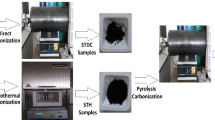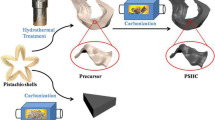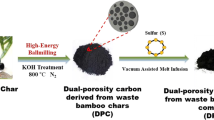Abstract
Hard carbon is considered to be a viable choice for anode materials in sodium-ion batteries due to its low cost and high specific capacity for sodium storage. The wasted grains derived from Chinese baijiu possess significant potential as biomass-based precursors for the production of hard carbon compounds. However, their use as biomass material has been mostly ignored. Therefore, this research focuses on the use of discarded grains from baijiu as a raw material for the production of porous hard carbon materials, specifically for the anode of sodium-ion batteries. The proposed synthesis procedure involves the use of a ZnCl2 chemical treatment to generate hard carbon materials that possess a porous structure and exhibit graphitic features. In comparison to the direct carbonization synthesis process, the use of ZnCl2 treatment on porous hard carbon results in notable enhancements in electrochemical performance, including specific capacity and rate capability, while simultaneously preserving exceptional long-term cycle stability. Especially, the enhanced capacity mostly manifests in the low-voltage plateau region, and the high plateau capacity can maintained even at higher specific currents, which is suitable for high-rate application, exceeding the typical commercial hard carbon materials used in sodium-ion batteries.







Similar content being viewed by others
Data availability
The data presented in this study are available on request from the corresponding author. The data are not publicly available due to restrictions, e.g., privacy or ethical.
References
W. Nitta Naoki, L.J. Feixiang, Tae, Li-ion battery materials: present and future. Mater. Today 18, 252–264 (2015)
J. Chen Tianmei, L. Yi, Y. Hanyu, L. Antao, C. Meiyi, X. Bing, Ying, Chen Qiang. Applications of Lithium-Ion batteries in Grid-Scale Energy Storage Systems. Trans. Tianjin Univ. 26, 208–217 (2020)
X. Li, L. Zifeng, J. Na, Y. Xiaojiao, D. Yibo, L. Li, R. Patrick, Simon Patrice, Liu Ying. Perovskite-type SrVO3 as high-performance anode materials for Lithium-ion batteries. Adv. Mater. 34, 2107262 (2021)
B. Soltani Niloofar, G. Amin, G. Lars, M. Thomas, Daria, Progress and challenges in using sustainable carbon anodes in rechargeable metal-ion batteries. Prog. Energy Combust. Sci. 87, 100929 (2021)
S. Mukherjee, S. Bin Mujib, D. Soares, G. Singh, Electrode materials for high-performance sodium-ion batteries. Materials 12(12), 1952 (2019)
S. Li Pengju, L. Yanglin, H. Ximing, L.X. Wenhuan, Fullerene-Intercalated Graphitic Carbon Nitride as a high-performance Anode Material for Sodium-Ion batteries. Energy Environ. Mater. 5, 608–616 (2022)
S. Perveen Tahira, S. Muhammad, I. Nadia, A. Rida, Abrar, Shahzad Muhammad Imran. Prospects in anode materials for sodium ion batteries - a review. Renew. Sustain. Energy Rev. 119, 109549 (2020)
L. Wei, S. Fei, B. Clement, Z. Hongli, J. Xiulei, H. Liangbing, Na-Ion Battery anodes: materials and Electrochemistry. Acc. Chem. Res. 49, 231–240 (2016)
Z. Chen Xinlong, Y.L. Wenjian, Z. Can, L. Sa, High-performance sodium-ion batteries with a hard carbon anode: transition from the half-cell to full-cell perspective. Nanoscale. 11, 22196–22205 (2019)
S. Tan, H. Yang, Z. Zhang, X. Xu, Y. Xu, J. Zhou, X. Zhou, Z. Pan, X. Rao, Y. Gu, Z. Wang, Y. Wu, X. Liu, Y. Zhang, The progress of hard carbon as an anode material in sodium-ion batteries. Molecules 28, 3134 (2023)
Z. Sun Shijiao, C.Y. Jian, W. Huanlei, Z. Xiangyu, Resol and urea derived N-doped porous carbon for Na-ion storage. Mater. Chem. Phys. 254, 123535 (2020)
B. Escobar, D.C. Martínez-Casillas, K.Y. Pérez-Salcedo, D. Rosas, L. Morales, S.J. Liao, L.L. Huang, Shi Xuan. Research progress on biomass-derived carbon electrode materials for electrochemical energy storage and conversion technologies. Int. J. Hydrog. Energy. 46, 26053–26073 (2021)
Z. Zhao Hanqing, Y. Dan, W. Jianqi, C. Pengfei, Maosheng, Li Zhong. Directional oxygen functionalization by defect in different metamorphic-Grade coal-derived Carbon materials for Sodium Storage. Energy Environ. Mater. 5, 313–320 (2022)
C. Guo Shuai, T. Yimeng, C. Liping et al., Biomass hard carbon of high initial coulombic efficiency for sodium-ion batteries: preparation and application. Electrochimica Acta 410, 140017 (2022)
T. Mathew, X. Qingbing, H. Zhe, Z.X. Song, A review on biomass-derived hard carbon materials for sodium-ion batteries. Mater. Adv. 2, 5881–5905 (2021)
Z. Nita Cristina, D.J. Biao, Matei Ghimbeu Camélia. Hard carbon derived from coconut shells, walnut shells, and corn silk biomass waste exhibiting high capacity for Na-ion batteries. J. Energy Chem. 58, 207–218 (2021)
P. Huang Tao, C. Da-chun, Zui, Xia Xiao-hong, Chen Yu-xi, Liu Hong-bo. Microstructures and electrochemical properties of coconut shell-based hard carbons as anode materials for potassium ion batteries. New Carbon Mater. 37, 1125–1132 (2022)
R. Thenappan Meenatchi, M.S. Subadevi, Hard Carbon reprising porous morphology derived from Coconut Sheath for Sodium-Ion Battery. Energies. 15, 8086 (2022)
H.-. Zhang, C. Chao, X. Hui, Yang Li-wen, Chen Jian. Hard Carbon Derived from Straw as Anode materials for sodium-ion batteries. Int. J. Electrochem. Sci. 17, 221113 (2022)
Y.-E. Zhu, G. Haichen, C.Y.-N.Y. Donghui, W. Jinping, Hard carbon derived from corn straw piths as anode materials for sodium ion batteries. Ionics 24, 1075–1081 (2018)
Q. Xu Tianyue, Z. Xuan, X. Xiang, Yongyao, Regulation of surface oxygen functional groups and pore structure of bamboo-derived hard carbon for enhanced sodium storage performance. Chem. Eng. J. 452, 139514 (2023)
J. Alvira Darío, Plant-derived hard carbon as anode for sodium-ion batteries: a comprehensive review to guide interdisciplinary research. Chem. Eng. J. 447, 137468 (2022)
A. Olajire Abass, The brewing industry and environmental challenges. J. Clean. Prod. 256, 102817 (2020)
M.S. Darlami, L. Christian, G.-U.J. Luis, C. Rosalía, C. Daniel, Balducci Andrea. Brewery waste derived activated carbon for high performance electrochemical capacitors and lithium-ion capacitors. Electrochim. Acta. 446, 142104 (2023)
M.S. Darlami, L. Christian, Gómez-Urbano Juan Luis, Carriazo Daniel, Balducci Andrea. Brewers’ spent grains-derived Carbon as Anode for Alkali Metal-Ion batteries. Energy Technol. 10, 2200379 (2022)
Raviolo, Sofía, Bracamonte María Victoria, Calderón Cecilia Andrea, Cometto Fernando Pablo, Luque Guillermina Leticia. A Green Solution to Energy Storage: brewers’ spent grains biocarbon–silica composites as high-performance Lithium-ion batteries anodes. Energy Technol. 11, 2300342 (2023)
T. Zhang Jian, M. Zhiqiang, S. Yiqian, H. Feilong, W. Jialing, T. Hao, Ling, Origin identification of the sauce-flavor chinese baijiu by organic acids, trace elements, and the stable carbon isotope ratio. J. Food Qual. 2019, 7525201 (2019)
L. Xiaogang, C. Rui, Z. Zhilei, R. Qingxi, S. Caihong, L. Yu, C. Xiaonian, Mao Jian, Conversion of baijiu distillers’ grains to functional peptides: process optimization and antioxidant activity evaluation. J. Funct. Foods. 108, 105722 (2023)
W. Weppner, R.A. Huggins, Determination of the Kinetic Parameters of Mixed-Conducting Electrodes and application to the System Li3Sb. J. Electrochem. Soc. 124, 1569 (1977)
Simões dos Reis, Mayandi Subramaniyam Glaydson, Cárdenas Angélica. Chandrasekar, Larsson Duarte, H. Sylvia, T. Mikael, L. Ulla, García-Alvarado. Flaviano, Facile synthesis of sustainable activated biochars with different pore structures as efficient additive-carbon-free anodes for lithium- and sodium-ion batteries. ACS Omega 7, 42570–42581 (2022)
H. Larsson Sylvia, M. Manon, T. Mikael, Application of design of experiments (DoE) for optimised production of micro- and mesoporous Norway spruce bark activated carbons. Biomass Convers. Biorefinery 13, 10113–10131 (2023)
Y. Liu Weidong, L. Juntao, Y. Shanjian, S. Weiming, Y. Yongming, Gaixiu, Zinc chloride-activated micro-mesoporous carbon material derived from energy grass and its electrocatalytic performance toward oxygen reduction reaction. J. Energy Storage. 46, 103697 (2022)
M.V. Bracamonte, G.I. Lacconi, S.E. Urreta, L. Foa Torres, E. F. on the nature of defects in Liquid-Phase Exfoliated Graphene. J. Phys. Chem. C 118, 15455–15459 (2014)
M.A. Pimenta, G. Dresselhaus, M.S. Dresselhaus, L.G. Cançado, A. Jorio, R. Saito, Studying disorder in graphite-based systems by Raman spectroscopy. Phys. Chem. Chem. Phys. 9, 1276–1290 (2007)
W. Yang Jinlin, D. Xiaowei, L. Wenrui, C. Xu, Z. Xinhang, Z. Weichao, L. Kexin, Ming, Zou Ruqiang, Loh Kian Ping, Yang Quan-Hong, Chen Wei. From Micropores to Ultra-micropores inside Hard Carbon: toward enhanced capacity in Room-/Low-Temperature sodium-ion storage. Nano-Micro Lett. 13, 98 (2021)
A. Au Heather, C.S. Hande, Jensen Anders, O. Emilia, A. O’Keefe Christopher, S. Thomas, C.-R. Maria, F. Headen Thomas, P. Grey Clare, C. Qiong, D. Alan, Titirici Maria-Magdalena. A revised mechanistic model for sodium insertion in hard carbons. Energy Environ. Sci. 13, 3469–3479 (2020)
T. Zhou Siyu, P. Zheng, H. Zhiyi, Z. Yuancheng, Z. Le, X.S. Dan, T. Yougen, S. Dhmees Abdelghaffar, Wang Haiyan. Regulating closed pore structure enables significantly improved sodium storage for hard carbon pyrolyzing at relatively low temperature. SusMat. 2, 357–367 (2022)
Acknowledgements
This research was funded by the Wuliangye Group Industry University Research Cooperation Project (CXY2021ZR002).
Author information
Authors and Affiliations
Contributions
QK and XL designed and supervised the project. LX and XL performed the experiments data analysis and wrote the paper. QZ, XA, JZ, and WY provided valuable comments and suggestions for the work. All the authors discussed the results and commented on the manuscript.
Corresponding authors
Ethics declarations
Conflict of interest
The authors declare no competing financial interest.
Additional information
Publisher’s Note
Springer Nature remains neutral with regard to jurisdictional claims in published maps and institutional affiliations.
Supplementary Information
Below is the link to the electronic supplementary material.
Rights and permissions
Springer Nature or its licensor (e.g. a society or other partner) holds exclusive rights to this article under a publishing agreement with the author(s) or other rightsholder(s); author self-archiving of the accepted manuscript version of this article is solely governed by the terms of such publishing agreement and applicable law.
About this article
Cite this article
Xu, L., Li, X., Zhou, Q. et al. Chinese baijiu spent grains-based high-performance porous hard carbon for sodium-ion battery anodes. J Mater Sci: Mater Electron 35, 448 (2024). https://doi.org/10.1007/s10854-024-12209-z
Received:
Accepted:
Published:
DOI: https://doi.org/10.1007/s10854-024-12209-z




